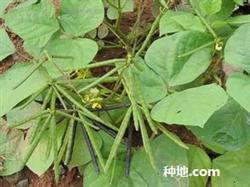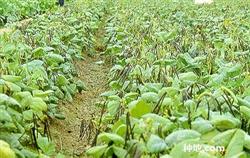How can mung beans be planted with high yield?

How can mung beans be planted with high yield? Please guide that mung bean is one of the important minor grain crops in China, which has the effect of reducing temperature and relieving summer heat, and integrates nutritional value and medicinal value. with the increasing improvement of people's living standards, people need more and more mung beans in order to adjust and improve their lives. while planting mung bean has the advantages of less investment, quick effect, high benefit and broad development prospects. The main results are as follows: (1) Mung bean is an important fertile crop in rotation, which requires the excellent production of cereal crops. Mung bean bogey continuous cropping, "bean field adjustment year after year, the yield is high year after year." Mung bean rotation patterns are: (a) one crop a year, such as mung bean, millet, sorghum and corn; (b) two crops a year, such as wheat and mung bean; (c) three cropping every two years, such as wheat, mung bean, wheat and mung bean (millet); and (d) five cropping every three years, such as wheat, mung bean, spring sugar cane, spring corn, wheat and mung bean (soybean). (2) there are five planting methods of mung bean: intercropping, interplanting, mixed cropping, multiple cropping and purebred. ① intercropping mung bean is not sensitive to light and is more resistant to shade. Taking advantage of the characteristics of short plant and nodule nitrogen fixation and fertilizer increase, it is often intercropped with tall stalk crops, fertilizing and ventilating with light, which is beneficial to increase the yield of main crops and double cropping in one place, so as to achieve the purpose of increasing income and raising land. There are two modes of intercropping. (a) mung beans, millet (sorghum). 2 rows of corn, 4 rows of mung beans or 2 rows of corn (sorghum), 2 rows of mung beans or 4 rows of corn, 2 rows of mung beans. Give priority to corn, increase the income of mung beans; give priority to mung beans, increase the income of corn. (B) mung beans, millet, commonly known as "millet riding donkey (green)", 1 millet, 4 rows of mung beans. Both mung beans and millet should increase production by 10%. ② interplanting (a) mung bean with sweet potato. Planting sweet potato on the ridge, hole sowing or strip sowing 1 row of mung beans in the ditch can harvest 40-50 kg more mung beans per mu and a lot of sweet potatoes. (B) Cotton with mung beans. Wide row 1.2 meters to grow mung beans, narrow row 0.5 meters to grow cotton. Cotton and green were sown at the same time, and mung beans were harvested in the cotton boll period. ③ hybrids generally sow or cover mung beans between rows or plants of corn and sorghum. It is usually used to fill the gap of main crops such as corn, so as to reduce the yield of main crops with lack of seedlings. And mung bean can raise land in barren land to achieve the purpose of increasing income. ④ multiple cropping and multiple cropping is mainly in multi-cropping areas, using wheat or other next crops to plant mung beans, implement more harvest in one land, and improve land utilization rate. There are wheat, mung bean, rice, mung bean, rape, mung bean and other planting methods. ⑤ purebred mung bean is planted once a year, which is mostly planted in thin sandy land, hilly land or sloping land with short frost-free period and barren, especially in arid areas with dry climate, thin soil layer, sparse population, short growth period and extensive management, and a certain yield can be obtained. (3) for fine soil preparation, mung bean cotyledons are large, and the top soil force is weak, so soil preparation requires deep ploughing and fine harrowing, empty and solid, no bumps, uniform depth and broken ground. The permeability of soil is good, which is beneficial to the development of rhizobia and the activity of soil microorganisms. Soil preparation requires deep ploughing in early autumn, thickening of living soil layer, and harrowing at the top of early spring. Click to get more mung bean planting technology click to get more grain and oil planting technology
- Prev

How to grow mung beans with high yield?
How to grow mung beans with high yield? Please guide that the price of mung bean is relatively stable in recent years, coupled with lax soil requirements, simple planting, and the area is expanding year by year, which has become a good project for farmers to grow rich. Developed countries do not attach importance to the production of miscellaneous grains and beans. After China's entry into WTO, the export volume of mung beans has increased, and the price has risen steadily.
- Next

How do mung beans prevent pest red spiders?
How do mung beans prevent pest red spiders? Please advise to give priority to chemical control. Strengthen the field inspection, found that the local spot occurred, timely administration of medicine and control. Use 50% malathion EC 1000 times, or 50% dibromophos 2000 times, or 25% deltamethrin 5000 times. Once every 7 days, 2 to 3 times in a row. ...
Related
- The first cup of black tea in spring, the flavor and history of tea gardens in Kenya, Africa
- The computer can not only choose potatoes, but also grow tea rice. AI will grow winter oolong tea champion.
- It is not only the inflated tea bitten by insects, but also engraved with the four seasons tea in Beipu.
- The Oriental Beauty Tea Festival in Zhuxian County takes the stage at the weekend to experience the plus-size feast of oil tea.
- & quot; Oriental Beauty Tea & Exploration of Emei in Hsinchu, the hometown of quot;
- The new variety of strawberry "Tainong 1" dessert is the first choice with mellow aroma. Crimson gorgeous
- History of Tea in Taiwan: from Wild Inner Mountain to Export Tea Garden
- Two types of Taiwan Oriental Beauty Black Tea won the British three-Star Award for Childhood Tea Xiang Zhang Jiaqi changed from pilot to champion tea maker.
- Banana species and varieties: the planting history of Taiwan Xianren banana and dwarf banana is long, is banana disease resistant?
- Coffee planting Technology: Qianjie Coffee from Seedling to harvesting

